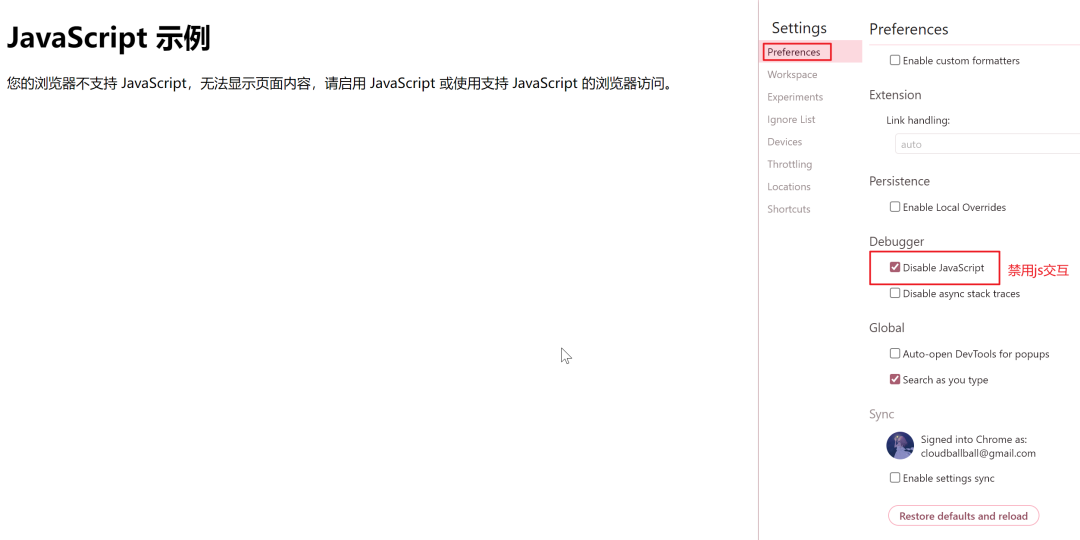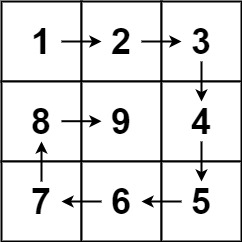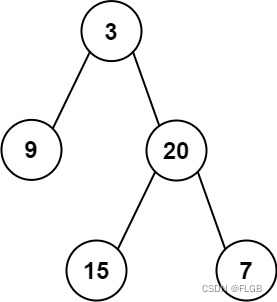
🏠专栏介绍:浅尝C++专栏是用于记录C++语法基础、STL及内存剖析等。
🎯每日格言:每日努力一点点,技术变化看得见。
文章目录
- list介绍
- list常用接口使用示例
- 构造类函数
- 迭代器
- 属性与元素获取
- 增删改操作
- list底层结构探索
- list模拟实现
- 正向迭代器实现
- 增删操作
- 属性获取操作
- 构造类函数
- 整体代码汇总
- list与vector比较
list介绍
- list是可以在常数范围内在任意位置进行插入和删除的序列式容器,并且该容器可以前后双向迭代。
- list的底层是双向链表结构,双向链表中每个元素存储在互不相关的独立节点中,在节点中通过指针指向其前一个元素和后一个元素。
- list与forward_list非常相似:最主要的不同在于forward_list是单链表,只能朝前迭代,已让其更简单高效。
- 与其他的序列式容器相比(array,vector,deque),list通常在任意位置进行插入、移除元素的执行效率更好。
- 与其他序列式容器相比,list和forward_list最大的缺陷是不支持任意位置的随机访问,比如:要访问list的第6个元素,必须从已知的位置(比如头部或者尾部)迭代到该位置,在这段位置上迭代需要线性的时间开销;list还需要一些额外的空间,以保存每个节点的相关联信息(对于存储类型较小元素的大list来说这可能是一个重要的因素)
list常用接口使用示例
下面仅给出list部分常用接口及使用示例,更多关于list接口的介绍请参阅->list参考文档
构造类函数
| 接口声明 | 接口描述 |
|---|---|
| list(size_type n, const value_type& val = value_type()) | 用n个值为val的元素构造list |
| list() | 构造空的list |
| list(const list& x) | 拷贝构造函数 |
| list(InputIterator first, InputIterator last) | 用[first,last)区间元素构造list |
下面给出上述接口的示例代码↓↓↓
#include <iostream>
#include <string>
#include <list>
using namespace std;
void testList()
{
list<int>lt1(5,8);
for(auto e : lt1)
{
cout << e << " ";
}
cout << endl;
list<int>lt2;
cout << "lt2's size is " << lt2.size() << endl;
list<int>lt3(lt1);
for(auto e : lt3)
{
cout << e << " ";
}
cout << endl;
string s = "Jammingpro";
list<char>lt4(s.begin(), s.end());
for(auto e : lt4)
{
cout << e << " ";
}
cout << endl;
}
int main()
{
testList();
return 0;
}

迭代器
| 接口声明 | 接口描述 |
|---|---|
| begin + end | 返回第一个元素的迭代器/返回最后一个元素的下一位置的迭代器 |
| rebegin + rend | 返回最后一个元素的下一位置/返回第一个元素的位置 |
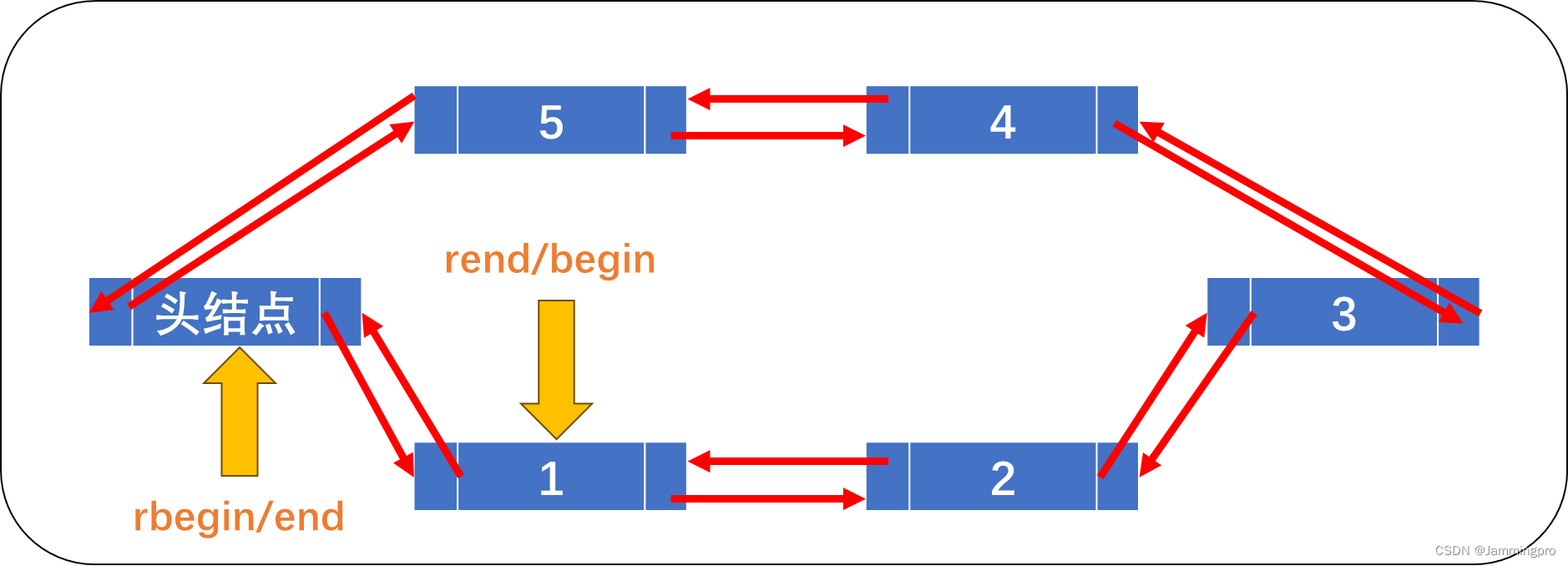
list底层是带头双向链表,begin指向第一个有效元素(头结点的后继节点),end指向头结点,迭代器begin每次++,每次向后移动,当与end重合时,则正向迭代结束。rbegin指向头结点,end指向第一个有效元素(头结点的后继节点),当要对rbegin解引用时,rbegin底层会执行*(rbegin->prev),返回rbegin指向节点的前驱节点的数据。即使rbegin指向头结点,但对它解引用获得的是头节后前驱节点的数据;当rbegin与end重合时则迭代结束。
下面来看一下list迭代器的使用示例代码↓↓↓
#include <iostream>
#include <string>
#include <list>
using namespace std;
void testList()
{
string s = "Jammingpro";
list<char>lt(s.begin(), s.end());
list<char>::iterator it = lt.begin();
while(it != lt.end())
{
cout << *it << " ";
++it;
}
cout << endl;
cout << "===================================" << endl;
list<char>::reverse_iterator rit = lt.rbegin();
while(rit != lt.rend())
{
cout << *rit << " ";
++rit;
}
cout << endl;
}
int main()
{
testList();
return 0;
}

对于const类型的list容器,需要配套使用const_iterator/const_reverse_iterator来进行正反向迭代。
★ps:begin与end为正向迭代器,对迭代器执行++操作,迭代器向后移动;rbegin(end)与rend(begin)为反向迭代器,对迭代器执行++操作,迭代器向前移动
属性与元素获取
| 接口声明 | 接口声明 |
|---|---|
| empty | 检查list是否为空 |
| size | 返回list中有效节点的个数 |
| front | 返回list的第一个节点中的值的引用 |
| back | 返回list的最后一个节点中的值的引用 |
上面接口相较简单,这里这届给出示例代码↓↓↓
#include <iostream>
#include <string>
#include <list>
using namespace std;
void testList()
{
string s = "Jammingpro";
list<char>lt;
cout << "lt is empty?" << lt.empty() << endl;
cout << "The size of lt is " << lt.size() << endl;
for(auto ch : s)
{
lt.push_back(ch);
}
cout << "lt is empty?" << lt.empty() << endl;
cout << "The size of lt is " << lt.size() << endl;
cout << "The first element is " << lt.front() << endl;
cout << "The last element is " << lt.back() << endl;
}
int main()
{
testList();
return 0;
}

增删改操作
| 接口声明 | 接口说明 |
|---|---|
| push_front | 在list首元素前插入值为val的元素 |
| pop_front | 删除list中第一个元素 |
| push_back | 在list尾部插入值为val的元素 |
| pop_back | 删除list中最后一个元素 |
| insert | 在pos位置中插入值为val的元素 |
| erase | 删除pos位置的元素 |
| swap | 交换两个list中的元素 |
| clear | 情况list中的有效元素 |
上面接口的使用示例代码如下↓↓↓
#include <iostream>
#include <string>
#include <list>
using namespace std;
void testList()
{
string s = "Jammingpro";
list<char>lt(s.begin(), s.end());
lt.push_back('!');
lt.push_front('@');
for(auto e : lt)
{
cout << e;
}
cout << endl;
lt.pop_back();
lt.pop_front();
for(auto e : lt)
{
cout << e;
}
cout << endl;
lt.insert(++lt.begin(), '#');
for(auto e : lt)
{
cout << e;
}
cout << endl;
lt.erase(++lt.begin());
for(auto e : lt)
{
cout << e;
}
cout << endl;
string s = "xiaoming";
list<char> lt2(s.begin(), s.end());
lt.swap(lt2);
for(auto e : lt)
{
cout << e;
}
cout << endl;
cout << "before clear size is " << lt.size() << endl;
lt.clear();
cout << "after clear size is " << lt.size() << endl;
}
int main()
{
testList();
return 0;
}

list底层结构探索
由监视窗口可以看到,list容器中包含指向头结点地址的指针及容器内有效元素的个数。每个节点包含前驱指针、后继指针及值域,故list底层是带头双向循环链表。

list模拟实现
在模拟list之前,由于list的结构是双向链表,因而需要定义节点类型。↓↓↓
template<class T>
struct node
{
node* _prev = nullptr;
node* _next = nullptr;
T _data;
node(const T& x = T())
:_data(x)
{}
};
正向迭代器实现
由于链表的各个节点无法实现++或者–操作,因此,我们需要将迭代器封装为一个类(结构体)。在该类(接口体)中重载迭代器的各种操作。其中Ptr就是T*,Ref就是T&。
若定义list<char>::iterator it,则*it是为了获取节点中存的数据,因此operator*中中需要返回节点的数值,即_node->_data。对于it的其他运算符重载如下方代码所示↓↓↓
template<class T, class Ptr, class Ref>
struct __list_iterator
{
typedef __list_iterator<T, Ptr, Ref> Self;
node<T>* _node;
__list_iterator(node<T>* node)
:_node(node)
{}
Ref operator*()
{
return _node->_data;
}
Self& operator++()
{
_node = _node->_next;
return *this;
}
Self operator++(int)
{
Self tmp(_node);
_node = _node->_next;
return tmp;
}
Self& operator--()
{
_node = _node->_prev;
return this;
}
Self operator--(int)
{
Self tmp(_node);
_node = _node->_prev;
return tmp;
}
bool operator==(const Self& lt)
{
return _node == lt._node;
}
bool operator!=(const Self& lt)
{
return _node != lt._node;
}
};
增删操作
void push_back(const T& val)
{
Node* tail = _head->_prev;
Node* newnode = new Node(val);
tail->_next = newnode;
newnode->_prev = tail;
newnode->_next = _head;
_head->_prev = newnode;
_size++;
}
void pop_back()
{
assert(!empty());
Node* tail = _head->_prev;
Node* tailPrev = tail->_prev;
tailPrev->_next = _head;
_head->_prev = tailPrev;
delete tail;
_size--;
}
void push_front(const T& val)
{
Node* first = _head->_next;
Node* newnode = new Node(val);
_head->_next = newnode;
newnode->_prev = _head;
newnode->_next = first;
first->_prev = newnode;
_size++;
}
void pop_front()
{
assert(!empty());
Node* first = _head->_next;
Node* second = first->_next;
_head->_next = second;
second->_prev = _head;
delete first;
_size--;
}
void insert(iterator pos, const T& val)
{
Node* cur = pos._node;
Node* prev = cur->_prev;
Node* newnode = new Node(val);
prev->_next = newnode;
newnode->_prev = prev;
newnode->_next = cur;
cur->_prev = newnode;
_size++;
}
void erase(iterator it)
{
Node* cur = it._node;
Node* prev = cur->_prev;
Node* next = cur->_next;
prev->_next = next;
next->_prev = prev;
delete cur;
_size--;
}
属性获取操作
bool empty() const
{
return _size == 0;
}
size_t size() const
{
return _size;
}
构造类函数
list()
:_head(new Node)
{
_head->_next = _head;
_head->_prev = _head;
}
list(const list<T>& lt)
{
Node* prev = _head;
Node* cur = _head;
Node* p = lt._head->_next;
while (p != lt._head)
{
cur = new Node(p->_data);
prev->_next = cur;
cur->_prev = prev;
p = p->_next;
}
_head->_prev = cur;
}
template<class InputIterator>
list(InputIterator first, InputIterator last)
{
_head = new Node;
_head->_next = _head;
_head->_prev = _head;
while (first != last)
{
push_back(*first);
first++;
}
}
整体代码汇总
由于我们自己模拟实现的list与库中重名,因此需要将其定义在命名空间内。
#include <iostream>
#include <cassert>
using namespace std;
namespace jammingpro
{
template<class T>
struct node
{
node* _prev = nullptr;
node* _next = nullptr;
T _data;
node(const T& x = T())
:_data(x)
{}
};
template<class T, class Ptr, class Ref>
struct __list_iterator
{
typedef __list_iterator<T, Ptr, Ref> Self;
node<T>* _node;
__list_iterator(node<T>* node)
:_node(node)
{}
Ref operator*()
{
return _node->_data;
}
Self* operator->()
{
return _node;
}
Self& operator++()
{
_node = _node->_next;
return *this;
}
Self operator++(int)
{
Self tmp(_node);
_node = _node->_next;
return tmp;
}
Self& operator--()
{
_node = _node->_prev;
return this;
}
Self operator--(int)
{
Self tmp(_node);
_node = _node->_prev;
return tmp;
}
bool operator==(const Self& lt)
{
return _node == lt._node;
}
bool operator!=(const Self& lt)
{
return _node != lt._node;
}
};
template<class T>
class list
{
typedef node<T> Node;
public:
//=====构造类函数=====
typedef __list_iterator<T, T*, T&> iterator;
typedef __list_iterator<const T, const T*, const T&> const_iterator;
iterator begin()
{
return iterator(_head->_next);
}
iterator end()
{
return iterator(_head);
}
const_iterator begin() const
{
return const_iterator(_head->_next);
}
const_iterator end() const
{
return const_iterator(_head);
}
list()
:_head(new Node)
{
_head->_next = _head;
_head->_prev = _head;
}
list(const list<T>& lt)
{
Node* prev = _head;
Node* cur = _head;
Node* p = lt._head->_next;
while (p != lt._head)
{
cur = new Node(p->_data);
prev->_next = cur;
cur->_prev = prev;
p = p->_next;
}
_head->_prev = cur;
}
template<class InputIterator>
list(InputIterator first, InputIterator last)
{
_head = new Node;
_head->_next = _head;
_head->_prev = _head;
while (first != last)
{
push_back(*first);
first++;
}
}
//=====增删操作=====
void push_back(const T& val)
{
Node* tail = _head->_prev;
Node* newnode = new Node(val);
tail->_next = newnode;
newnode->_prev = tail;
newnode->_next = _head;
_head->_prev = newnode;
_size++;
}
void pop_back()
{
assert(!empty());
Node* tail = _head->_prev;
Node* tailPrev = tail->_prev;
tailPrev->_next = _head;
_head->_prev = tailPrev;
delete tail;
_size--;
}
void push_front(const T& val)
{
Node* first = _head->_next;
Node* newnode = new Node(val);
_head->_next = newnode;
newnode->_prev = _head;
newnode->_next = first;
first->_prev = newnode;
_size++;
}
void pop_front()
{
assert(!empty());
Node* first = _head->_next;
Node* second = first->_next;
_head->_next = second;
second->_prev = _head;
delete first;
_size--;
}
void insert(iterator pos, const T& val)
{
Node* cur = pos._node;
Node* prev = cur->_prev;
Node* newnode = new Node(val);
prev->_next = newnode;
newnode->_prev = prev;
newnode->_next = cur;
cur->_prev = newnode;
_size++;
}
void erase(iterator it)
{
Node* cur = it._node;
Node* prev = cur->_prev;
Node* next = cur->_next;
prev->_next = next;
next->_prev = prev;
delete cur;
_size--;
}
//=====属性获取类函数=====
bool empty() const
{
return _size == 0;
}
size_t size() const
{
return _size;
}
private:
Node* _head;
size_t _size = 0;
};
void test()
{
list<int> lt;
lt.push_back(1);
lt.push_back(2);
lt.push_back(3);
lt.push_back(4);
lt.push_back(5);
lt.pop_back();
lt.pop_back();
lt.insert(lt.begin(), 888);
lt.erase(lt.begin());
lt.push_front(666);
lt.pop_front();
list<int>::iterator it = lt.begin();
while (it != lt.end())
{
cout << *it << " ";
++it;
}
string s = "jammingpro";
list<char>lt2(s.begin(), s.end());
for (char ch : lt2)
{
cout << ch << endl;
}
}
}
list与vector比较
| vector | list | |
|---|---|---|
| 底层结构 | 动态顺序表,一段连续空间 | 带头双向循环链表 |
| 随机访问 | 支持随机访问,访问某个元素效率为O(1) | 不支持随机访问,访问某个元素效率为O(N) |
| 插入和删除 | 任意位置插入与删除效率低,需要移动数据,时间复杂度为O(N);同时,插入元素时可能需要扩容(开辟空间并拷贝旧数据,释放旧空间),导致效率较低 | 任意位置插入与删除效率高,无需移动数据,时间复杂度为O(N) |
| 空间利用率 | 底层为连续空间,不容易造成内存碎片,空间利用率高,缓存利用率高 | 底层为动态开辟节点,小节点容易造成内存碎片,空间利用率低,缓存利用率低 |
| 迭代器 | 原生指针 | 对原生指针进行封装 |
| 迭代器失效 | 在插入元素是,要给迭代器重新赋值;因为插入元素可能导致扩容,导致迭代器指向旧空间(迭代器失效);删除数据时,也需要给迭代器重新赋值(VS下迭代器失效,g++下不失效) | 插入元素不会导致迭代器失效,删除元素会导致迭代器失效 |
| 使用场景 | 需要高效存储,支持随机访问,不关心插入删除效率 | 大量插入和删除操作,不关心随机访问效率 |
🎈欢迎进入浅尝C++专栏,查看更多文章。
如果上述内容有任何问题,欢迎在下方留言区指正b( ̄▽ ̄)d

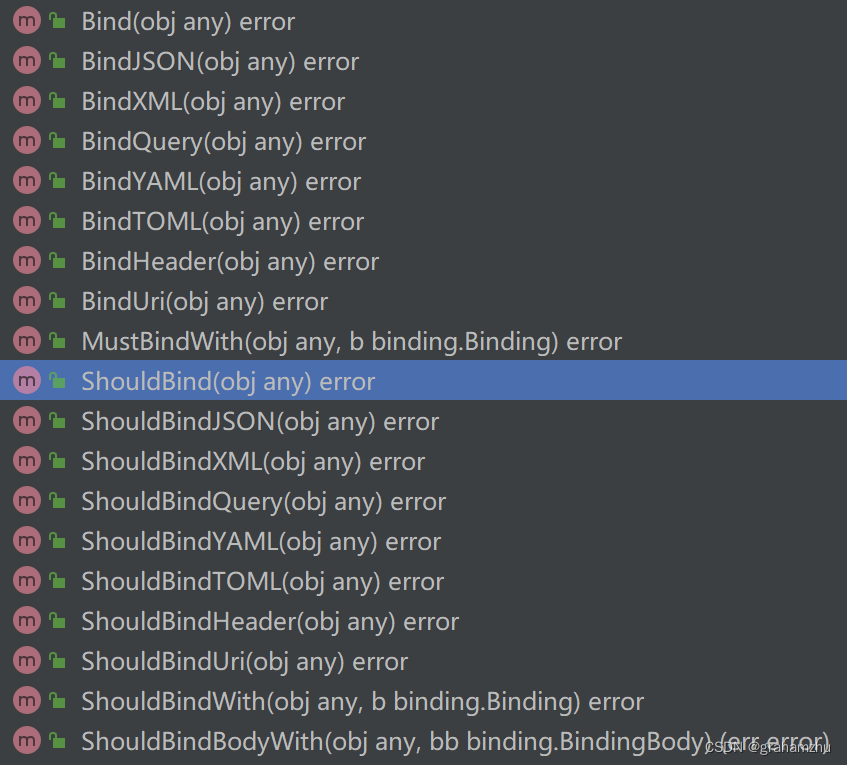

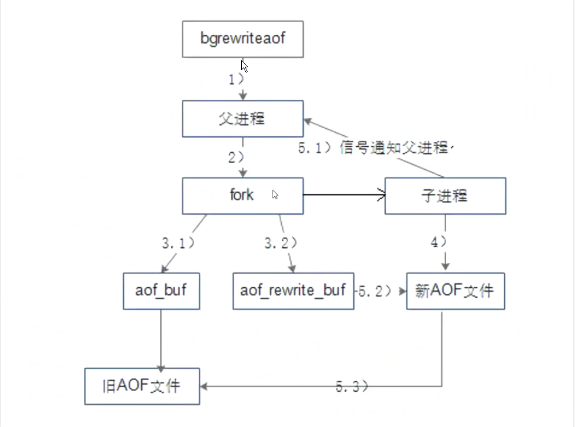
![[Linux] 排查问题指令top/ps/netstat](https://img-blog.csdnimg.cn/direct/e250025b38ee4a96aec93b1d51ce5774.png)

